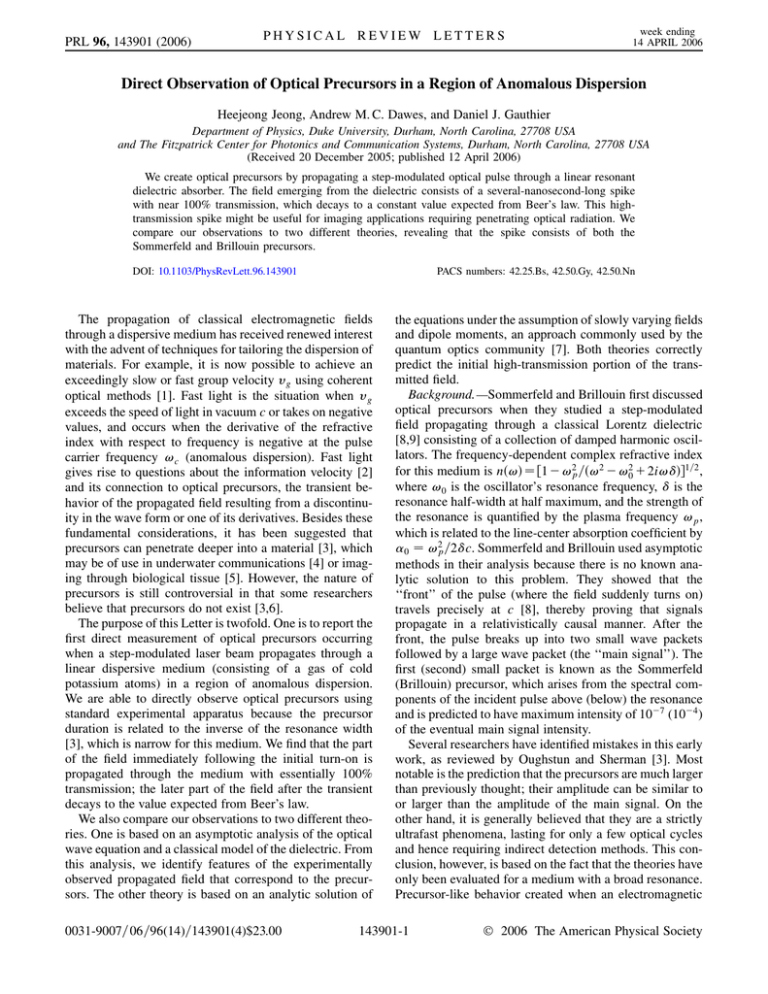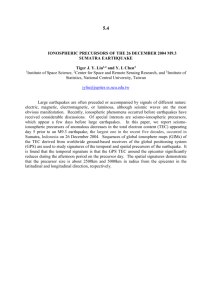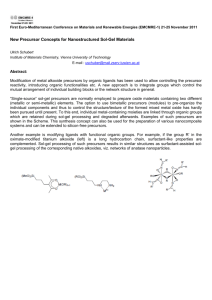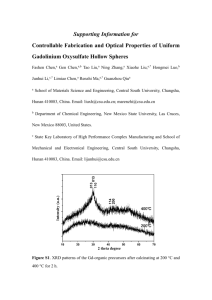Direct Observation of Optical Precursors in a Region of Anomalous... Heejeong Jeong, Andrew M. C. Dawes, and Daniel J. Gauthier
advertisement

PRL 96, 143901 (2006) PHYSICAL REVIEW LETTERS week ending 14 APRIL 2006 Direct Observation of Optical Precursors in a Region of Anomalous Dispersion Heejeong Jeong, Andrew M. C. Dawes, and Daniel J. Gauthier Department of Physics, Duke University, Durham, North Carolina, 27708 USA and The Fitzpatrick Center for Photonics and Communication Systems, Durham, North Carolina, 27708 USA (Received 20 December 2005; published 12 April 2006) We create optical precursors by propagating a step-modulated optical pulse through a linear resonant dielectric absorber. The field emerging from the dielectric consists of a several-nanosecond-long spike with near 100% transmission, which decays to a constant value expected from Beer’s law. This hightransmission spike might be useful for imaging applications requiring penetrating optical radiation. We compare our observations to two different theories, revealing that the spike consists of both the Sommerfeld and Brillouin precursors. DOI: 10.1103/PhysRevLett.96.143901 PACS numbers: 42.25.Bs, 42.50.Gy, 42.50.Nn The propagation of classical electromagnetic fields through a dispersive medium has received renewed interest with the advent of techniques for tailoring the dispersion of materials. For example, it is now possible to achieve an exceedingly slow or fast group velocity g using coherent optical methods [1]. Fast light is the situation when g exceeds the speed of light in vacuum c or takes on negative values, and occurs when the derivative of the refractive index with respect to frequency is negative at the pulse carrier frequency !c (anomalous dispersion). Fast light gives rise to questions about the information velocity [2] and its connection to optical precursors, the transient behavior of the propagated field resulting from a discontinuity in the wave form or one of its derivatives. Besides these fundamental considerations, it has been suggested that precursors can penetrate deeper into a material [3], which may be of use in underwater communications [4] or imaging through biological tissue [5]. However, the nature of precursors is still controversial in that some researchers believe that precursors do not exist [3,6]. The purpose of this Letter is twofold. One is to report the first direct measurement of optical precursors occurring when a step-modulated laser beam propagates through a linear dispersive medium (consisting of a gas of cold potassium atoms) in a region of anomalous dispersion. We are able to directly observe optical precursors using standard experimental apparatus because the precursor duration is related to the inverse of the resonance width [3], which is narrow for this medium. We find that the part of the field immediately following the initial turn-on is propagated through the medium with essentially 100% transmission; the later part of the field after the transient decays to the value expected from Beer’s law. We also compare our observations to two different theories. One is based on an asymptotic analysis of the optical wave equation and a classical model of the dielectric. From this analysis, we identify features of the experimentally observed propagated field that correspond to the precursors. The other theory is based on an analytic solution of 0031-9007=06=96(14)=143901(4)$23.00 the equations under the assumption of slowly varying fields and dipole moments, an approach commonly used by the quantum optics community [7]. Both theories correctly predict the initial high-transmission portion of the transmitted field. Background.—Sommerfeld and Brillouin first discussed optical precursors when they studied a step-modulated field propagating through a classical Lorentz dielectric [8,9] consisting of a collection of damped harmonic oscillators. The frequency-dependent complex refractive index for this medium is n! 1 !2p =!2 !20 2i!1=2 , where !0 is the oscillator’s resonance frequency, is the resonance half-width at half maximum, and the strength of the resonance is quantified by the plasma frequency !p , which is related to the line-center absorption coefficient by 0 !2p =2c. Sommerfeld and Brillouin used asymptotic methods in their analysis because there is no known analytic solution to this problem. They showed that the ‘‘front’’ of the pulse (where the field suddenly turns on) travels precisely at c [8], thereby proving that signals propagate in a relativistically causal manner. After the front, the pulse breaks up into two small wave packets followed by a large wave packet (the ‘‘main signal’’). The first (second) small packet is known as the Sommerfeld (Brillouin) precursor, which arises from the spectral components of the incident pulse above (below) the resonance and is predicted to have maximum intensity of 107 (104 ) of the eventual main signal intensity. Several researchers have identified mistakes in this early work, as reviewed by Oughstun and Sherman [3]. Most notable is the prediction that the precursors are much larger than previously thought; their amplitude can be similar to or larger than the amplitude of the main signal. On the other hand, it is generally believed that they are a strictly ultrafast phenomena, lasting for only a few optical cycles and hence requiring indirect detection methods. This conclusion, however, is based on the fact that the theories have only been evaluated for a medium with a broad resonance. Precursor-like behavior created when an electromagnetic 143901-1 © 2006 The American Physical Society PHYSICAL REVIEW LETTERS PRL 96, 143901 (2006) field propagates through a variety of media has been observed [4,10 –12], but none have made a quantitative comparison with the modern asymptotic theory [3] for a resonant dielectric in a region of anomalous dispersion. Experiments. —To measure directly optical precursors, we prepare a dielectric medium consisting of a cloud of cold potassium (39 K) atoms generated in a vapor-cell magneto-optic trap, as shown in Fig. 1(a). The atoms are illuminated by trapping and repumping lasers tuned to the 4S1=2 $ 4P3=2 transition resulting in a cloud that has a temperature of 400 K, a diameter of 1–2 mm (which we take to be the length L of the medium), and an atomic number density of 1:2 1010 cm3 . The repumping beam is repeatedly switched off for 20 s and turned back on for 80 s. While the repumping beam is off, the potassium atoms are optically pumped into the 4S1=2 (F 1) hyperfine level (90% efficiency) by the trapping beam. The optical precursor experiment is conducted on the 4S1=2 F 1 $ 4P1=2 F 2 transition (transition wavelength 770 nm) after the optical pumping phase of the experiment is completed. The transition is well separated from the other potassium optical transitions so that we are interacting essentially with a single resonance (resonance frequency !0 ). Hence, the gas of atoms behave like a single-resonance Lorentz dielectric. To determine and !p (which we recall is related to 0 ), we measure the frequency-dependent steady-state transmission (output intensity/input intensity) of the gas using a very weak probe laser beam. We observe a Lorentzian-like resonance of width 2=2 9:6 MHz, which is broader than the 6 MHz natural linewidth due to residual Doppler broad- (a) MZM 39 K MOT PMT Laser L Ed g e g e ne r a t o r Os c i l l o s c o p e Transient Transmission (b) 1.0 α0L = 0.00 0.8 0.6 α0L = 0.41 0.4 (b) 0.2 α0L = 1.03 0.0 0 50 100 150 Time (ns) 200 FIG. 1. Direct observation of optical precursors. (a) Experimental setup. (b) Experimentally observed optical transmission through the cloud of atoms (solid line). Dots are predicted by Eq. (5) with no adjustable parameters. week ending 14 APRIL 2006 ening and Zeeman shifts. We determine the line-center absorption coefficient through Beer’s law: T exp0 L, where T is the line-center steady-state transmission of the probe beam. By changing the trapping conditions, we adjust the atomic number density and propagation length to obtain two different experimental conditions, one resulting in T 0:66 (corresponding to L 0:12 cm, 0 3:41 cm1 , 0 L 0:41, and !p 2:48 109 s1 ) and another leading to T 0:36 (corresponding to L 0:20 cm, 0 5:14 cm1 , 0 L 1:03, and !p 3:05 109 s1 ). Both of these experimental situations give rise to fast light when !c !0 , for which g =c ’ 1 0:25!2p =2 1 1 0:50 c=1 , giving g =c 5:9 104 for 0 3:41 cm1 , and 3:9 104 for 0 5:14 cm1 . A step-modulated field is created by passing a weak continuous-wave laser (frequency !c ) through a 20 GHz bandwidth Mach-Zehnder modulator (MZM, EOSpace, Inc.) driven by an electronic edge generator (Data Dynamics, Model 5113) whose edge is steepened using a back recovery diode (Stanford Research Systems, Model DG535). The peak intensity of the pulse is 64 W=cm2 , which is much less than the saturation intensity of the transition (3 mW=cm2 ). The pulse is detected with a fast-rise-time (0.78 ns) photomultiplier tube (PMT, Hamamatsu, Model H6780-20) and the resulting electrical signal is measured with a 1 GHz analog-bandwidth digital oscilloscope (Tektronix, Model TDS 680B). In the absence of the atoms, we measure an edge rise time (10%–90%) of 1:7 ns for our complete system, corresponding to a bandwidth of 206 MHz. This time is short in comparison to the expected duration of the precursors so that our finiterise-time experimental results should be similar to that predicted by the theory, which assumes instantaneousresponse components [3]. Results.—Figure 1(b) shows the temporal evolution of the step-modulated pulse propagating through the cloud of atoms for the case of different absorption path lengths 0 L and the case when !c !0 , where the dispersion is anomalous. For moderate absorption (0 L 0:41), the pulse intensity rises immediately to 95% of the incident pulse height and then decays to the steady-state value expected from Beer’s law. As discussed below, the initial high-transmission transient spike is made up of both the Sommerfeld and Brillouin precursors. The time scale of the transient spike, defined as the time from the initial turn-on to the 1=e decay of the precursors, is found to be 32 ns. For the maximum absorption path length (0 L 1:03), the initial transmission also reaches 95%, decays more rapidly (16 ns), and reaches the steady-state value expected from Beer’s law. It is important to realize that the transient spike observed in our experiment is not a nonlinear optical phenomenon, such as an optical nutation. We work with extremely weak pulses and we have verified that our observations are conducted in the linear-optics regime. 143901-2 PRL 96, 143901 (2006) We also see from Fig. 1(b) that the leading edge of all the pulses occur at the same time. This observation is consistent with Sommerfeld’s prediction that the pulse front propagates at c. If the group velocity predicted the speed of the pulse front, we would have expected that the leading edge would be advanced by 6.8 ns for the case when 0 L 0:41 and 17.0 ns for 0 L 1:03. Thus, our experiment is consistent with relativistically causal information propagation in a region of anomalous dispersion [2]. Analysis: Asymptotic theory.—To determine which part of the observed signals correspond to the precursors, we evaluate the asymptotic analysis presented in Ref. [3] for our experimental conditions. In this analysis, the incident beam is taken as a step-modulated sinusoidal electric field of the form Ein z 0; t E0 t sin!c t, where t is the unit step function. The transmitted field can be written in three distinct parts: the Sommerfeld precursor ES z; t (see Eq. 7.2.20 in Ref. [3]), the Brillouin precursor EB z; t (Eq. 7.3.66), and the main signal EC z; t (Eq. 8.3.4). For !c !0 , we find that the frequency of ES z; t [EB z; t] starts off at infinity (zero) and rapidly approaches !c . The time it takes to approach !c depends linearly on the penetration depth z; for 0 L 1:03, the precursor frequency is within !c in 10 fs, which is comparable to a few optical periods (2.6 fs long optical period). Beyond 10 fs, we find that the field components can be written as harmonic functions oscillating rapidly at !c modulated by a slowly varying envelope. They are given by ES z; t E0 ze sin!c =4; (1) p EB z; t E0 ze sin!c =4= 3; (2) EC z; t E0 e0 z=2 sin!c ; =3=2 =2 week ending 14 APRIL 2006 PHYSICAL REVIEW LETTERS (3) the main signal. Thus, Fig. 1(b) constitutes the first direct measurement of precursors in the optical domain for a stepmodulated field propagating through a medium characterized approximately as a single-resonance Lorentz dielectric. A detailed analysis of Eqs. (1)–(3) reveals some surprises. For the case of the largest absorption path length (0 L 1:03), L 1:30 1010 , which is unphysical [we expect it should be of the order of 1 so that the jEz; tj & E0 ]. We do not understand the origin of this discrepancy. One possibility is that 0 L needs to be larger because our experiment is conducted on the theory’s boundary of validity. However, we would have to increase 0 L by a factor of 10100 to make jEz; tj E0 , which seems unreasonable. An additional surprise is the =4 phase shift in the harmonic terms. For !c !0 , we expect that all components of the transmitted field should be in phase with the incident field. Future investigations of the asymptotic theory in the narrow-resonance regime is needed to addresses these apparent problems. Analysis: SVA.—Another theoretical approach for understanding our experiments is to assume that the plasma p frequency is small (!p 8!0 ), the material resonance is narrow ( !0 ), the field is nearly resonant with the material oscillators (!c !0 ), and that the field varies slowly [7,13]. Under these assumptions, known as the slowly varying amplitude (SVA) approximation, it is possible to obtain an analytic solution describing the propagation of the step-modulated field through the dielectric, where the complex refractive index is given by n! ’ 1 !2p =4!! !0 i [13–15]. The field is given by 1 X Ez; t E0 e0 z=2 e 1n n1 p 0 z=2n=2 Jn 20 z sin!c ; z1=2 , and t z=c is where z !0 0 the retarded time. The asymptotic analysis is valid in the so-called mature-dispersion limit (0 z 1); our experiment with the largest 0 L borders on this limit and thus we expect that it will only give a qualitative understanding of our results. From Eqs. (1)–(3), it is seen that the precursors and the main signal arrive immediately after the front and that the Sommerfeld and Brillouin precursors decay exponentially with an intensity time constant of 1=2 16:6 ns for 0 L 1:03. This result confirms our earlier statement that the persistence of the precursors is governed by the resonance width. The precursor amplitudes are also modulated by a z1=2 spatial dependence and they are out of phase, resulting in a partial cancellation of their combined amplitudes. Furthermore, we see that the main signal is just the incident step-modulated field reduced in amplitude by an amount expected from Beer’s law. Based on these findings, we conclude that the transient spike observed in our experiments [Fig. 1(b)] is composed of both the Sommerfeld and Brillouin precursors, which sit on top of E0 e 1 X (4) p 0 z=2n=2 Jn 20 z sin!c ; n0 (5) where the series in Eq. (4) [Eq. (5)] converges when p p 0 z=2 < 1 0 z=2 > 1. The first term of Eq. (4) represents the main signal and is identical to EC z; t of the asymptotic theory [see Eq. (3)]. The second term is the transient response of the propagated field and hence should be equal to the sum of the two precursors ES z; t EB z; t. It is not easily separated into the individual Sommerfeld and Brillouin precursor fields, yet we can compare the total precursor field. Evaluation of Eqs. (4) and (5) reveals that the intensity transmission jumps to 100% immediately after the front. To make a direct comparison to our observations, we take into account the finite-rise time of our step-modulated 143901-3 PHYSICAL REVIEW LETTERS PRL 96, 143901 (2006) 1.0 1.0 (a) E(z,t) / E0 0.6 0.2 0.2 -0.2 -0.2 0 20 40 60 0 1.0 1.0 (c) 0.6 0.2 -0.2 -0.2 20 40 20 40 Col 1 vs Col 2 Col 3 vs Col 4 60 0 20 60 (d) 0.6 0.2 0 (b) 0.6 40 60 Time (ns) FIG. 2. Temporal evolution of the total precursor field envelope for the SVA theory (solid line) and the scaled asymptotic theory (dotted line) for (a) z 0:2 cm, (b) 2 cm, (c) 20 cm, and (d) 200 cm. pulse and detection system by convolving the intensity transmission function with a single-pole low-pass filter with a 206 MHz 3 dB roll-off frequency. The filtering reduces the transmission to 95% immediately after the front. The dots in Fig. 1(b) show the predicted low-passfiltered intensity transmission function with no free parameters. It is seen that the agreement with the experimental observations is excellent. Comparing theories.—While both theories correctly predict a transient spike, the asymptotic theory appears to have some problems, as discussed above. To gain some insight into this issue, we compare only the total precursor fields predicted by the two theories for different absorption path lengths that extend well into the mature-dispersion regime where the asymptotic theory should be valid. We find that the problems discussed above continue to persist even for large 0 L. Thus, based on an empirical analysis, we have set the =4 phase shift in Eqs. (1) and (2) to zero and scaled the precursor amplitudes by 1=z. With these modifications to the asymptotic theory, we find that there is good agreement between them even for L 0:2 cm [corresponding to the experimental data shown in Fig. 1(b) with 0 L 1:03], as seen in Fig. 2(a). As the path length increases [Figs. 2(b)–2(d)], the SVA theory predicts oscillations in the field envelope that are not present in the asymptotic theory. The oscillations are due to the absorption of the central part of the pulse spectrum by the material resonance and subsequent beating between the remaining sidebands [7,14,15]. Over the three-order-of-magnitude change in path length shown in Fig. 2, we see that the maximum amplitude of the week ending 14 APRIL 2006 oscillations is in reasonable agreement with the asymptotic theory, indicating that our empirical scale factor captures most of the discrepancy between the theories. Note that our scale factor explicitly removes the z1=2 dependence of the precursor amplitudes predicted by the asymptotic theory. Discussion.—Obviously, both the asymptotic and SVA theories predict a transient spike in the propagated field immediately after the front, as observed in our experiment. This result is somewhat surprising. In early quantum optics research on pulse propagation, Crisp [7] states—without proof—that making the SVA necessarily throws out the precursor contribution to the propagated field. Our research demonstrates clearly that this is an incorrect conclusion. We believe that some of the controversy surrounding the observability of optical precursors is related to this misunderstanding. We gratefully acknowledge discussions of this research with Kurt Oughstun and the financial support of the NSF through Grant No. PHY-0139991. [1] R. W. Boyd and D. J. Gauthier, Progress in Optics 43, edited by E. Wolf (Elsevier, Amsterdam, 2002), Chap. 6. [2] M. D. Stenner, D. J. Gauthier, and M. A. Neifeld, Nature (London) 425, 695 (2003). [3] K. E. Oughstun and G. C. Sherman, Electromagnetic Pulse Propagation in Causal Dielectrics (Springer-Verlag, Berlin, 1994). [4] S.-H. Choi and U. Österberg, Phys. Rev. Lett. 92, 193903 (2004). [5] R. Albanese, J. Penn, and R. Medina, J. Opt. Soc. Am. A 6, 1441 (1989). [6] O. Avenel, M. Rouff, E. Varoquaux, and G. A. Williams, Phys. Rev. Lett. 50, 1591 (1983); T. M. Roberts, Phys. Rev. Lett. 93, 269401 (2004); U. J. Gibson and U. L. Österberg, Opt. Express 13, 2105 (2005); R. R. Alfano et al., Phys. Rev. Lett. 94, 239401 (2005). [7] M. D. Crisp, Phys. Rev. A 1, 1604 (1970). [8] L. Brillouin, Wave Propagation and Group Velocity (Academic Press, New York, 1960). [9] J. D. Jackson, Electrodynamics (Wiley, New York, 1999), 3rd ed., pp. 322 –339. [10] P. Pleshko and I. Palócz, Phys. Rev. Lett. 22, 1201 (1969). [11] J. Aaviksoo, J. Kuhl, and K. Ploog, Phys. Rev. A 44, R5353 (1991). [12] M. Sakai et al., Phys. Rev. B 66, 033302 (2002). [13] R. W. Boyd, Nonlinear Optics (Academic Press, San Diego, 2003), 2nd ed.. [14] E. Varoquaux, G. A. Williams, and O. Avenel, Phys. Rev. B 34, 7617 (1986). [15] J. Aaviksoo, J. Lippmaa, and J. Kuhl, J. Opt. Soc. Am. B 5, 1031 (1988). 143901-4


![This article was downloaded by: [Duke University] On: 17 May 2011](http://s2.studylib.net/store/data/011492180_1-0f5b6aee41a74d332ff9860bc4746043-300x300.png)

